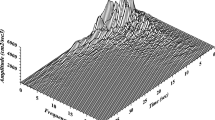Abstract
One of the unresolved aspects of simulated earthquake testing concerns the amount of low-cycle fatigue produced by a series of single-frequency-vibration tests compared to random-motion excitation. The recommended sinebeat vibration input using 5 cyc/beat at each measured equipment natural frequency is considered conservative because it can produce more fatigue damage than the most severe earthquake being postulated.
A computer-aided analysis has been made of simple mass-spring-damper systems representing the uncoupled structure and equipment response to well-known acceleration-time histories available for both the El Centro-1940 and San Fernando-1971 earthquakes. In the proposed testmachine simulation, the comparable sine-beat-vibration input was adjusted to duplicate the building-floor response at the base of the equipment, which was represented as a series of oscillators geometrically spaced in the 1 to 25-Hz range of damaging earthquake effects. Both large- and small-strain ranges have been compared, but these values are assumed for convenience and cannot be used as actual seismic effects in specific pieces of equipment.
Similar content being viewed by others
References
Manson, S. S., “Fatigue: A Complex Subject-Some Simple Approximations”,Experimental Mechanics,5 (4),193–226 (1965).
Fischer, E. G., “Sine Beat Vibration Testing Related to Earthquake Response Spectra”,The S. & V. Bull. 42, Part 2, Naval Research Lab., Washington, DC (Jan. 1972).
Fischer, E. G. andParr, A. A., “Mathematical Model Analysis for the Dynamic Design of Machinery”,Experimental Mechanics,7 (10),27A-34A (1967).
Colaiaco, A. P. and Albert, W. S., “Seismic Testing of Metal Clad and Metal Enclosed Switchgear Using Sine Beat Vibrations,” IEEE Power Engn. Soc. Winter Meet., January 30–February 4, 1972, New York, (Jan. 30–Feb. 4, 1972).
Fackler, W. C., “Equivalence Techniques for Vibration Testing”,The S. & V. Mono. Series, SVM-9, Naval Research Lab., Washington, DC (1972).
Teledyne Geotronics, “Strong Motion Data Library, An Earthquake Data Storage and Analysis Service”, Long Beach, CA.
Tezcan, S. S. andIpek, M., “Long Distance Effects of the 28 March 1971 Gediz Turkey Earthquake”,Earthquake Engn. and Structural Dyn.,1,203–215 (1973).
Author information
Authors and Affiliations
Rights and permissions
About this article
Cite this article
Fischer, E.G., Wolff, F.H. Comparison of fatigue effects in simulated and actual earthquakes. Experimental Mechanics 13, 531–538 (1973). https://doi.org/10.1007/BF02322342
Issue Date:
DOI: https://doi.org/10.1007/BF02322342




